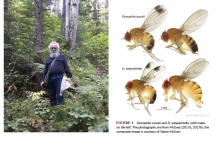Why is Wolbachia-induced cytoplasmic incompatibility so common?

michael Turelli
University College Davis, US
Link to seminar: https://umontpellier-fr.zoom.us/webinar/register/WN_mQAPh5HyT4Cn1v7mEJAjPw
Summary
Cytoplasmic incompatibility (CI) is the most common reproductive manipulation produced by Wolbachia, obligately intracellular alphaproteobacteria that infect roughly half of all insect species. Once infection frequencies within host populations approach 10%, intense CI can drive Wolbachia to near fixation within 10 generations. However, natural selection among Wolbachia variants within individual host species does not favor enhanced CI. Indeed, variants that eliminate CI, but enhance host fitness, are expected to spread –– if infected females remain protected from CI (Turelli 1994). Nevertheless, roughly half of Wolbachia infections cause detectable CI. What selects for and maintains this phenotype? CI-causing Wolbachia variants preferentially spread into new host species because CI increases equilibrium infection frequencies and CI-causing variants can remain at high frequencies even when conditions change so that initially beneficial Wolbachia infections become deleterious to their hosts. In contrast, CI does little to help establish beneficial Wolbachia in new host species. An epidemiological model describing Wolbachia gain and loss by host species and the loss of CI-induction within Wolbachia lineages yields simple expressions for the frequency of Wolbachia-infected host species and the fraction of those infections causing CI. CI exemplifies a common phenotype whose frequency and persistence is more plausibly explained by increased spread to new host lineages rather than preferential spread within host lineages (i.e., classical natural selection). Recent Wolbachia acquisitions by many hosts species, plus data suggesting ongoing spatial spread within host species and rapid evolution of CI-inducing loci (particularly degradation), support a determinative role for differential interspecific transmission in maintaining CI.
Contact: mylene.weill@umontpellier.fr
Contact du Comité SEEM: seem@services.cnrs.fr. Contact du Labex CEMEB: cemeb-gestion@umontpellier.fr


